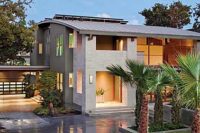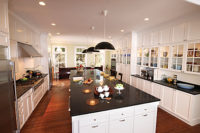Miami, FL. In recreating the client’s master and guest bathroom and kitchen, the design architects incorporated their firm’s overall green-design philosophy, while featuring natural stone and mosaic tiles in the design.
In the master bathroom, a unique feature wall was formed above the vanity with Autumn slate mosaics, which were supplied by Opus Stone of Miami, FL. The rich colors found in the strips of slate bring a warm, yet rustic feel to the space. To complement the mosaic feature wall, 24- x 24-inch tiles of St. Croix stone with a honed finish were employed as flooring.
“[St. Croix stone] combined very well with the slate mosaic we installed on the feature wall,” said Brun. “The cream-colored floor was the ideal field color for the highly textured and varied slate mosaic. We did not want anything to compete with the feature wall, so the natural choice was this low-key stone — St. Croix.”
St. Croix stone was also carried over as flooring in the guest bath. In this space, the light-colored material was contrasted with vibrant aqua-colored glass tiles, which resemble the shades of the ocean. The rectangular-shaped mosaics create a striking accent wall above the vanity.
“We used St. Croix stone for the guest bathroom because it was the closest to resemble the floor material on the pool deck, which was a honed key stone in a French pattern,” said Brun. “It felt like a very natural choice because it seamlessly transitions to the exterior.”
In remodeling the kitchen, Brun and Esparza decided to incorporate 24- x 24-inch Emperador dark brown marble tiles — supplied by Opus Stone — for the floor, since a darker stone was fit to create an intimate and tropical experience. To complement the color scheme, the design architects decided to use Compac Quartz Absolut Blanc for the kitchen countertops.
“People often erroneously associate tropical weather with light colors,” said Brun. “That is correct if the location is on the beach; however, if it’s inland and more associated with forests and dense vegetation, floor surfaces tend to be darker. When properly shaded, darker floors also give the room a more tropical, calming and soothing sensation.”
The design architect noted that before both he and his wife decided to use natural stone for the remodel, they strongly considered porcelain tile. “Stone was finally selected because it has a much warmer, rustic feel that could not be replicated,” Brun said. In addition to selecting natural stone, a passive green design was incorporated in areas such as the lightening and cabinetry — tying in with the overall design philosophy of the firm.
In designing each space with its own color scheme, the client was extremely involved in the selection process. “Due to time constraints, we didn’t view mock-ups,” said Brun. “But our client was very involved in the decision process — hand picking each material with us in the showroom.”
Overall, the most challenging aspect of the project came as the products were set in place. “The installation in the master bathroom definitely proved to be more difficult,” said Brun. “The materials started changing colors when they became wet, so we immediately had to apply a sealer.”
Spending an abundance of time on site, the architects were able to complete this redesign in approximately four months. “We have received an overwhelmingly positive reaction from our client, editors and our professional peers,” said Brun. “The project also won an American Institute of Architects Award for Interior Design.” N






